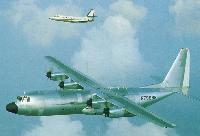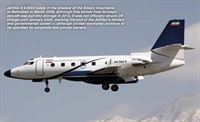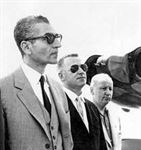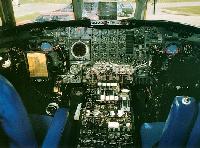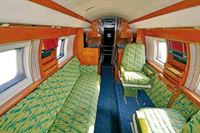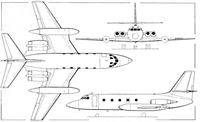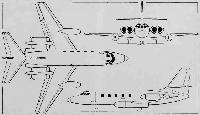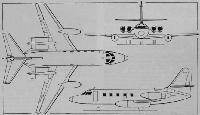
Lockheed 1329 JetStar I/II
Под ожидавшиеся требования ВВС США к созданию легкого транспортного самолета, предусматривающего широкое использование новых коммерческих технологий в данной области, компания "Lockheed" разработала модель Lockheed 1329 JetStar. Это был низкоплан со стреловидным крылом и хвостовым оперением, оснащавшийся парой ТРД Bristol Orpheus 1/S тягой по 21,57 кН. Первый из двух опытных самолетов был облетан 4 сентября 1957 года. Результаты испытаний были многообещающими, однако после неудачи с лицензионным выпуском двигателей Orpheus компания "Lockheed" решила ставить на первые серийные самолеты двигатели Pratt & Whitney JT12A-6 тягой по 13,34 кН - они монтировались попарно с каждой стороны фюзеляжа. Впрочем, активного интереса у военных к новой машине не возникло, поэтому большая часть из 204 построенных самолетов JetStar была продана гражданским заказчикам как бизнес-джеты. Производство машины было прекращено в 1980 году.
Варианты
JetStar I: базовая серийная модификация, отличалась от первого опытного самолета увеличенной емкостью топливной системы - за счет временной установки дополнительного топливного бака под каждой консолью крыла, а также наличием антиобледенительной системы крыла и хвостового оперения и установкой двигателей JT12A-6; несколько удлиненный фюзеляж обеспечил стандартную вместимость экипажа из двух человек и 10 пассажиров; поздние серийные машины получили двигатели JT12A-8 тягой по 14,68 кН
JetStar 731: переоборудованный подразделением "AiResearch" компании "Garrett" вариант, на котором заменили двигатели Pratt & Whitney на Garrett TFE731-1, отличавшиеся лучшей топливной экономичностью; по данному стандарту переоборудовано около 60 самолетов JetStar I
JetStar II: новая серийная модификация с двигателями Garrett TFE731-3 и рядом изменений
C-140A: пять самолетов для ВВС США, в целом схожие с ранними серийными JetStar I и оснащенные оборудованием для калибровки навигационных радиомаяков
C-140B: конвертируемый в грузовой или пассажирский вариант, для ВВС США построено пять самолетов; в остальном в целом идентичны C-140A
VC-140B: шесть дополнительно построенных серийных машин, в целом схожих с C-140A, за исключением того, что были оборудованы под VIP-транспортные варианты; пять C-140B были также переоборудованы по данному стандарту
ТАКТИКО-ТЕХНИЧЕСКИЕ ХАРАКТЕРИСТИКИ
Lockheed JetStar II
Тип: легкий транспортный самолет
Силовая установка: четыре ТРД Garrett TFE731-3 тягой по 16,45 кН
Летные характеристики: максимальная крейсерская скорость на высоте 9145 м - 880 км/ч; практический потолок 13105 м; дальность с максимальной полезной нагрузкой 4820 км
Масса: пустого эксплуатационная 11294 кг; максимальная взлетная 20185 кг
Размеры: размах крыла 16,59 м; длина 18,41 м; высота 6,22 м; площадь крыла 50,40 м2
- Описание
Фотографии
-
Air International 2006-08 / M.Jerram - Lockheed JetStar - A Classic Bizjet /Commercial/
Регистрационный номер: N329J [3] The first JetStar, N329J - note that it only has two engines. Pictured at Vancouver prior to its move to Seattle for display in the Museum of Flight.
-
Мировая Авиация 175
VC-140 - вариант VIP-транспортного самолета, принадлежал ВВС США и на закате своей карьеры эксплуатировался 89-м транспортным авиакрылом, дислоцированным на авиабазе Эндрюс. К 1986 году самолет был отправлен на авиабазу Дэвис-Монтан на хранение.
-
Air International 2006-08 / M.Jerram - Lockheed JetStar - A Classic Bizjet /Commercial/
JetStar 6s were the first variant of this classic business jet and used four Pratt & Whitney JT12A-6s (the '6' in the engine designation was adopted to identify the model). This aircraft bears the famous registration, N1, and was flown by the Federal Aviation Agency (later renamed Federal Aviation Administration).
-
Air Enthusiast 2006-09 / K.Wilson - Taking a Hit /Post-war combat/
Lockheed C-140A Jetstar, 62-4198 was a welcome addition to the BDR area at Mildenhall, although its activities could better be described as GIA rather than battle damage.
-
Air International 2006-08 / M.Jerram - Lockheed JetStar - A Classic Bizjet /Commercial/
Genesis of the JetStar came about due to two USAF requirements, though orders from the US military never reached the hoped - for number and only totalled 16. Some of these aircraft were used for navigational aid checking, while others - like the aircraft pictured - were employed on VIP duties, which included carrying US Presidents. VC-140B, 61-2492 flew in the latter role and now resides at the USAF Museum at Wright-Patterson AFB (at Dayton).
-
Aviation Historian 32 / B.Taghvaee - The shah's Jetstars
Регистрационный номер: EP-VRP [2] The original EP-VRP (c/n 5002), acquired by the Shah of Iran in June 1963, is seen here in the summer of 1967 during a visit to Gatwick Airport in the UK.
-
Aviation Historian 32 / B.Taghvaee - The shah's Jetstars
Регистрационный номер: EP-VRP [2] Unlike its identically registered predecessor, the second EP-VRP, JetStar 8 c/n 5137, was painted in a very austere overall dark gunship-grey scheme which robbed the aircraft of a great deal of its natural elegance. It is seen here taxying at Paris-Orly sometime during the early 1970s. The type’s distinctive 565 US gal (2,140lit) wing-mounted slipper tanks were initially trialled on the second prototype and fitted to all production JetStar 6s and 8s.
-
Air Enthusiast 1972-06 / ??? - Arabian Fledgling ... the Royal Saudi Air Force
One of the two immaculate Lockheed JetStars (103) of the Royal Flight seen at Riyadh. Frequently used by governmental officials. the JetStars are serviced and flown by US personnel provided by the Lockheed company.
-
Aviation Historian 32 / B.Taghvaee - The shah's Jetstars
Регистрационный номер: CF-DTF The Canadian government was one of the first non-corporate operators of the JetStar 6, two being acquired by the Department of Transport in early 1962. Seen here at a Canadian airport in October 1966 is the second to be delivered, CF-DTF (c/n 5088), in a colour scheme that emphasises the type’s rather purposeful lines.
-
Air International 2006-08 / M.Jerram - Lockheed JetStar - A Classic Bizjet /Commercial/
Lockheed followed the JetStar 6 with the JetStar 8, which featured the more powerful '-8' variant of the Pratt & Whitney JT12A engine. Sixty-six of this version were produced. Few JetStar 8s are still in service, so this active Mexican Air Force example is a rarity.
-
Мировая Авиация 174
Прототип L-100-30 в полете сопровождает Lockheed Jetstar. У L-100-30 удлиненный на 2,03 м фюзеляж. Этот вариант остается основной гражданской моделью "Hercules", но все может измениться, если начнет продаваться L-100J - гражданский эквивалент C-130J.
Другие самолёты на фотографии: Lockheed C-130 Hercules - США - 1954
-
Изд-во Schiffer / S.Markman & B.Holder - One-of-a-kind research aircraft
Регистрационный номер: N814NA [2] The GPAS aircraft, early in its career, prior to the addition of its fuselage-mounted pylon.
-
Изд-во Schiffer / S.Markman & B.Holder - One-of-a-kind research aircraft
Регистрационный номер: N814NA [2] GPAS aircraft performing laminar flow studies. Notice that the wing-mounted fuel tanks have been removed.
-
Изд-во Schiffer / S.Markman & B.Holder - One-of-a-kind research aircraft
The GPAS with a scale model unducted fan mounted on the fuselage pylon. Also note the instrumentation boom mounted below the nose.
-
Air International 2006-08 / M.Jerram - Lockheed JetStar - A Classic Bizjet /Commercial/
Регистрационный номер: N777EP JetStars were used by a number of celebrities, among them Elvis Presley, who owned this JetStar 6, N777EP, now on display at Graceland, his former home in Memphis.
-
Мировая Авиация 175
Регистрационный номер: N711Z [3] Построили около 40 JetStar II, отличавшихся увеличенной на 4111 л - в сравнении с JetStar I - емкостью топливной системы. Крыльевые баки на JetStar II были вынесены насколько возможно вперед.
-
Aviation Historian 32 / B.Taghvaee - The shah's Jetstars
Delivered in 1976 as EP-VLP, JetStar II c/n 5203 sported the updated variant’s Garrett AiResearch TFE731-3 turbofan engines and revised non-removable auxiliary fuel tanks glove-mounted on the wings in place of the previous variants’ slipper tanks. Sadly, 5-9001 (as it became) was destroyed in a fatal accident on approach to Isfahan in January 1995, in which several high-ranking IRIAF officers were killed.
-
Air International 2006-08 / M.Jerram - Lockheed JetStar - A Classic Bizjet /Commercial/
Регистрационный номер: N65JT Lockheed’s JetStar looks like no other business jet and gained fame for its appearance in the James Bond film Gold finger. Three variants saw service: the Jetstar 6, JetStar 8 and JetStar II. Pictured is a Garrett TFE-731-1-powered JetStar II.
-
Air International 1994-08 / Talkback
Регистрационный номер: LY-AMB Lockheed Jetstar 731 LY-AMB passed through Shannon, Ireland, on June 18, 1994 on its delivery flight for the Lithuanian Presidential Flight. Constructor's no. 5161, this aircraft first flew on May 21, 1973, as a Jetstar 8 and served with Esmark Inc and Smith International before being converted to a Jetstar 731 in December 1978. It then served as an executive transport with such companies as Southland Executive Charter and Mellon Bank. Prior to delivery to Lithuania the aircraft had an interior refit and was repainted in the new red, grey and white livery of Lithuanian Airlines.
-
Air International 2006-08 / M.Jerram - Lockheed JetStar - A Classic Bizjet /Commercial/
Регистрационный номер: 7T-VHP [2] Another famous JetStar is 7T-VHP, used by the Government of Palestine for transporting Yasser Arafat. This JetStar II used to wear the livery of Air Algerie, which flew it on behalf of the Government of Palestine. It has been stored at Geneva Airport for the last 18 months.
-
Aviation Historian 32 / B.Taghvaee - The shah's Jetstars
The Islamic Republic of Iran Air Force’s last operational JetStar, serial 5-9003, on finals into Mehrabad in March 2009. The IRIAF operated a total of four examples of the type in three variants. This aircraft, initially an Iraqi Airways machine, was appropriated by the IRIAF after having been flown to Iran to avoid the Gulf War in 1991.
-
Aviation Historian 32 / B.Taghvaee - The shah's Jetstars
JetStar II 5-9003 lands in the shadow of the Alborz mountains at Mehrabad in March 2009. Although this former Iraqi Airways aircraft was put into storage in 2015, it was not officially struck off charge until January 2020, marking the end of the JetStar’s military and governmental career - although civilian examples continue to be operated by corporate and private owners.
-
Air International 2006-08 / M.Jerram - Lockheed JetStar - A Classic Bizjet /Commercial/
Регистрационный номер: N380AA In the mid-1980s American Aviation Enterprises offered to re-engine JetStars with a pair of General Electric CF34-1A turbofans. One aircraft was converted by the company, N380AA, and the new variant was given the name FanStar. The aircraft is pictured at the 1986 National Business Aviation Association show in 1986 at Long Beach Airport, California, though no orders were received.
-
Aviation Historian 32 / B.Taghvaee - The shah's Jetstars
Регистрационный номер: N329J [3] First photograph of the Lockheed CL-329 JetStar utility transport powered by two Bristol Orpheus turbojets. Performance with these engines has surpassed all estimates, and the JetStar may be offered to customers in this as well as the four-engine layout.
CL-329 first prototype N329J (c/n 1001) made its maiden flight from the Lockheed Air Terminal at Burbank, California, on September 4, 1957, fitted with two Bristol Orpheus turbojets and minus the wing-mounted slipper tanks that became such a distinctive feature of production aircraft. This example survives at the Museum of Flight in Everett, Washington, USA. -
Jane's All the World Aircraft 1974 / 01 - Aircraft
Lockheed Model 1329 JetStar business jet (four Pratt & Whitney JT12A-8 turbojet engines)
-
Air Pictorial 1977-11
Регистрационный номер: N3080 World Carpet Corporation's JetStar 6 N3080 nightstopped at Yeadon on 4/9/77 in connection with the Harrogate Carpet Fair
-
Jane's All the World Aircraft 1966 / 02 - Aircraft
Lockheed JetStar light jet transport (four Pratt & Whitney JT12A-6A turbojet engines)
-
Jane's All the World Aircraft 1972 / 01 - Aircraft
Lockheed C-140A JetStar of the US Air Force Communications Service
-
Jane's All the World Aircraft 1964 / 01 - Aircraft
Lockheed C-140A JetStar in the insignia of the Air Force Communications Service
-
Air Pictorial 1976-10
Регистрационный номер: N5527L The first Lockheed JetStar II. N5527L, taking off on its maiden flight at Marietta, Georgia, on 18th August. The aircraft is powered by four 3,700-lb. s.t. Garrett 731-3 turbofans
-
Jane's All the World Aircraft 1975 / 01 - Aircraft
Регистрационный номер: N731JS First 731 JetStar re-engined with TFE 731-3 turbofans by AiResearch Aviation Company. The JetStar II will be generally similar
-
Jane's All the World Aircraft 1976 / 01 - Aircraft
Регистрационный номер: N711Z [3] Lockheed Model 1329-25 JetStar II executive transport {four AiResearch TFE 731-3 turbofan engines)
-
Air Pictorial 1999-07 / R.Jackson - Airport Movements
Регистрационный номер: 7T-VHP [2] The Palestinian Authority's JetStar II 7T-VHP brought Yasser Arafat into Dublin for a meeting with the Irish Government on 3/5/99
-
Jane's All the World Aircraft 1980 / Encyclopedia of Aviation - Aircraft A-Z - v4
Lockheed JetStar II.
-
Aviation Historian 32 / B.Taghvaee - The shah's Jetstars
The Shah inspects a JetStar at the Lockheed factory at Marietta, Georgia, in 1962. He liked what he saw and ordered a single example to be fitted to a VIP spec.
-
Air Enthusiast 2006-09 / K.Wilson - Taking a Hit /Post-war combat/
The cockpit of the Mildenhall C-140A was completely intact.
-
Aviation Historian 32 / B.Taghvaee - The shah's Jetstars
The interior of JetStar 8 c/n 5137 - originally the second EP-VRP and subsequently given the serial 5-9001 - was fitted with a wood-panelled VIP interior and could accommodate six passengers in two-tone green seats. The starboard panel of the forward cabin bulkhead incorporated an altimeter, clock and airspeed indicator.
-
Aviation Historian 32 / B.Taghvaee - The shah's Jetstars
Behind the first row of two rear-facing seats were a bench and two more seats facing each other, as seen in this photograph looking aft. Beyond the bench and rearmost seat was a small galley, with the lavatory at the rear of the aircraft. Retired from service in 1993 after 24 years of service, 5-9001 remains in storage at Mehrabad.
-
Aviation Historian 32 / B.Taghvaee - The shah's Jetstars
Sadly, 5-9001 was destroyed in a fatal accident on approach to Isfahan in January 1995, in which several high-ranking IRIAF officers were killed.
-
Air Pictorial 1973-06
Регистрационный номер: N711Z [3] Impression of the Lockheed JetStar II with TFE-731-3 turbofan engines.
-
Air Pictorial 1957-11
LOCKHEED CL-329 JETSTAR. Unchallenged leader in the field to develop and produce a new "off-the-shelf" light utility jet transport and crew readiness trainer for the U.S.A.F. is the Lockheed Aircraft Company. Its CL-329 JetStar took to the air for the first time on 4th September, just 241 days after development was authorised. Nearest rival to the JetStar is the North American Sabreliner now under construction. The prototype JetStar (N329J) is powered by two Bristol Orpheus turbojet engines (one each side of the rear fuselage) while a second prototype now nearing completion will be fitted with either four General Electric J-85 or Fairchild J-83 engines. By installing the Bristol engines Lockheed will be able to press forward with flight trials whilst awaiting delivery of the American engines. The engine location is designed to provide a minimum noise level in the cabin, and in the event of a nose-up landing the engines will be protected by the belly and low-set wing. The wing has a 34-degree sweep on the leading edge and owing to its location none of the structure interferes with cabin space. Stabilizer, which has similar sweep to the wing, is mounted approximately one-quarter of the way up the fin and is of the all-flying type. The cabin has accommodation for ten passengers and is pressurised to maintain an altitude of 8,000 ft. when the aircraft is flying at 45,000 ft. There is ample baggage room, and a galley may be fitted. A crew of two is the normal complement.
-
Jane's All the World Aircraft 1972 / 01 - Aircraft
Lockheed JetStar four-engined light jet transport
-
Jane's All the World Aircraft 1974 / 01 - Aircraft
Lockheed JetStar four-engined light jet transport
-
Jane's All the World Aircraft 1975 / 01 - Aircraft
Lockheed JetStar II executive transport (four AiResearch TFE 731-3 turbofan engines)
-
Jane's All the World Aircraft 1976 / 01 - Aircraft
Lockheed JetStar II executive transport (four AiResearch TFE 731-3 turbofan engines)
- Фотографии










